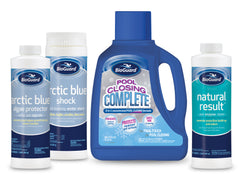
Winterizing Your Swimming Pool
Why should I winterize my pool?
If you live in a climate that has temps that get below freezing in the winter, you will need to winterize your pool in order to prevent damage to your pool and equipment. Water freezing in pipes can cause them to burst which can be very difficult and costly to repair.
Proper closing of the pool in the fall not only makes for an easier pool opening in the spring, but also helps protect your pool and equipment from damage during the winter.

When should I close my pool?
We recommend beginning your off-season pool closing once the pool water temperatures drop below 65° F. This process can take a couple days to complete, so it's best to start preparing for this process before temps are likely to fall below freezing.
Winterization procedures may vary by region, pool type, and preferences. This is a general guide to winterization, but we recommend consulting your pool manufacturer if you have concerns about your specific pool or equipment.
How do I winterize my pool?
Swimming Pool Winterization Steps
Preparation: Before winterizing, assess the overall condition of your pool. Address any issues with the water such as algae growth, cloudy water, high metal levels, etc. prior to winterizing. Test the water and make sure the pH, alkalinity, and other levels are properly balanced to protect from scale build up and corrosion over the winter.
For best results, we recommend having a water sample analyzed by a professional to know the proper actions to take to address any water issues. You can contact LeisureQuip at 866-546-8882 to learn more about the services that we offer like mail in water tests to assist.

Step 1: Make sure pool walls and surfaces are thoroughly clean. Remove debris. Brush and vacuum pool. Clean the waterline.
Ensuring pool walls and surfaces are clean prior to closing will help prevent permanent staining and will help minimize issues when opening your pool up again in the spring.
Suggested cleaning product: BioGuard Off the Wall
Step 2: With pump running, add chemicals. Follow label instructions for your size pool. Circulate for 24-48 hours continuously after adding chemicals to allow products to work effectively..
- Apply Arctic Blue Shock
- Next, add Arctic Blue Algae Protector
Optional (Included in Deluxe Winterizing Kit):
- Pool Closing Complete (helps control waterline buildup, protects equipment from scale and corrosion during the cold months)
- Pool Enzyme such as BioGuard Natural Result to help break down organic contaminants
Step 3: Lower the water level – this will depend on your pool type and the cover you are using. Follow the recommendations of your pool manufacturer/builder.
- Vinyl liner: Water level should be 1 inch below skimmer opening or tile line, whichever is lower.
- Plaster: Water should be 6 inches below skimmer line if using a solid cover. For a mesh cover, water should be lowered to 18-24 inches below skimmer or tile line. For an automatic pool cover, keep the water level no lower than the bottom of the skimmer.
- Above ground pool: Water level should be 3-4" below the opening of the skimmer
Step 4: Backwash and clean the filter & pump. We recommend chemically cleaning the filter. Clean out skimmer baskets.
Recommended filter cleaning products: BioGuard Strip-Kwik or BioGuard Kleen It
Step 5: Blow out water lines and plumbing with an air compressor or shop vac to prevent damage from freezing. Winterize or remove/store equipment as needed. For an above ground pool, disconnect the lines, allow water to drain, and then air dry. Store in a dry place.
(These instructions are not meant to be completely comprehensive, only a general guide. Please follow the manufacturer's instructions to prevent any damage to your pool or equipment over the winter.)
Step 6: Remove pool accessories such as ladders and railings if possible. Put away pool cleaning tools and equipment. Store in a clean and dry place.
- BioGuard Stow-Away cleaner can be used to clean pool accessories prior to storage
Step 7: For white plaster pools only, other pool types skip to Step 8.
Place BioGuard Arctic Blue Chlorine Floater in the deep end of the pool.
Monitor pool water temp over the winter and add a new chlorine floater every 30 to 45 days when water temperature is above 60°.
Step 8: Cover pool. Check pool cover for holes or damage. If your pool is not securely covered it can allow debris to enter the pool. You may need to remove excess debris that collects on the cover over the winter to prevent the cover from being weighed down. For an above ground pool, you can place a pool air pillow under the cover to help compensate for the pressure of the snow on top of the cover.






